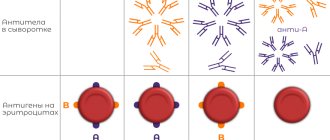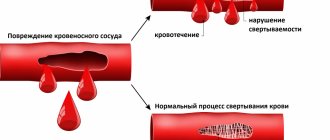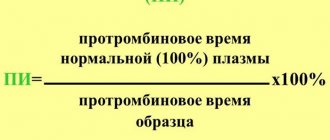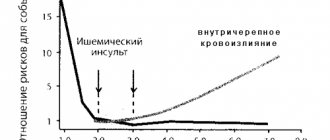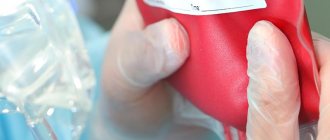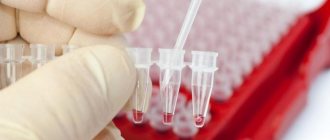The activated partial thromboplastin time (aPTT) test characterizes the state of one of the three mechanisms of the hemostatic system - coagulation (blood clotting). Using the APTT analysis, all types of hemophilia are diagnosed - A, B and C, as well as hereditary, autoimmune diseases and the phases of DIC syndrome are determined.
You can take the APTT test and get reliable results with a transcript of the analysis in the Laboratory of Hemostasis Pathologies at the MLC, the base clinic of Moscow State Medical University named after. Sechenov.
When is an APTT test prescribed?
APTT is part of the blood tests for hemostasis, which are taken when planning pregnancy. The test is also prescribed for genetic predisposition to thrombosis, spontaneous bleeding of unknown origin, diagnosis of hemophilia, treatment of heart attack, during pre- and postoperative examinations.
Based on the results of the analysis, the presence of coagulation inhibitors is determined - signs of systemic lupus erythematosus and antiphospholipid syndrome, severe autoimmune pathologies. The APTT test is also used to monitor heparin therapy.
Complexes with this research
Examination during pregnancy.
1st trimester 10,390 ₽ Composition Miscarriage Identification of the main causes of miscarriage 29,050 ₽ Composition
Examination during pregnancy. 3rd trimester 5,730 ₽ Composition
IN OTHER COMPLEXES
- Joining IVF RUB 15,030
- Female infertility RUB 9,790
- Coagulogram RUB 1,110
- Extended coagulogram RUB 2,730
- Pregnancy planning. Clinical indicators RUB 3,880
Benefits of analysis
APTT is a highly focused study that diagnoses several pathologies of hemostasis. The coagulation mechanism of hemostasis ensures the “sealing” of damage in blood vessels with fibrin clots and is influenced by blood coagulation factors.
Using the APTT test, you can detect a deficiency of the main factors affecting coagulation:
- 2nd, prothrombin;
- 5th, proaccelerin;
- 8th, antihemophilic globulin;
- 9th factor;
- 10th, Fr. Stewart-Prower;
- 11th, Dr. Rosenthal;
- 12th, Dr. Hagemann.
Activated partial thromboplastin time (aPTT)
Activated partial thromboplastin time, or aPTT, is the time it takes for a blood clot to form after calcium chloride and other reagents are added to the plasma. It reflects the work of the so-called internal pathway and the general cascade of the human blood coagulation system and is the most sensitive indicator of blood coagulation.
Synonyms Russian
Activated partial thromboplastin time, cephalin-kaolin time.
English synonyms
Partial Thromboplastin Time (PTT), Activated Partial Thromboplastin Time, aPTT, APTT.
Research method
Side scatter detection method, end point percentage determination.
Units
Sec. (second).
What biomaterial can be used for research?
Venous blood.
How to properly prepare for research?
- Do not eat for 12 hours before the test.
- Avoid physical and emotional stress 30 minutes before the test.
- Do not smoke for 30 minutes before donating blood.
General information about the study
Activated partial thromboplastin time (aPTT) characterizes the intrinsic pathway of blood coagulation. APTT is the time it takes for a clot to form in a blood plasma sample after adding special activators of this process. In this way, the degree of influence of blood clotting factors on the formation of a blood clot is assessed.
The duration of APTT depends on the level of high molecular weight kininogen, prekallikrein and coagulation factors XII, XI, VIII and is less sensitive to changes in the amount of factors X, V, prothrombin and fibrinogen. APTT is determined by the duration of blood clot formation after calcium and partial thromboplastin are added to the blood sample. An increase in aPTT duration is associated with an increased risk of bleeding, while a decrease is associated with thrombosis. This indicator is used separately to monitor therapy with direct anticoagulants (heparin).
What is the research used for?
- For the diagnosis of hemophilia.
- To monitor heparin anticoagulant therapy.
- For the diagnosis of deep hypofibrinogenemia, dysfibrinogenemia and disorders of fibrin monomer polymerization.
- To determine the patient’s predisposition to bleeding (as part of preoperative procedures).
When is the study scheduled?
- If the patient has bleeding or bruising of unknown origin, thromboembolism or disseminated intravascular coagulation, which can cause both bleeding and blood clots.
- When carrying out heparin therapy or when transferring a patient from heparin therapy to long-term treatment with warfarin.
- As part of a preoperative examination to identify the body's tendency to bleed, especially if the proposed operation is associated with a large loss of blood or the patient's clinical history indicates earlier bleeding.
- In the treatment of myocardial infarction.
What do the results mean?
Reference values: 21.1 - 36.5 sec.
An increase in aPTT indicates a tendency to bleed: blood clotting lasts longer than usual, which often indicates a deficiency of one of the coagulation factors or the effect of some inhibitor on the body's ability to form thrombosis.
What can influence the result?
- The presence of impurities of direct anticoagulants (in particular, heparin) in the blood sample
- High concentration of lipids (fats) in the blood, for example, after eating a fatty meal the night before the test
Important Notes
- When very high doses of heparin are used, for example during open heart surgery, the APTT test loses its sensitivity - thrombus formation is greatly reduced.
- The APTT test is not prescribed as a routine screening test. It is needed if the patient’s medical history indicates a hereditary tendency to thrombosis or hemophilia. Asymptomatic patients are often screened for aPTT before surgery, especially when their physician believes it will help determine the risk of excess bleeding during surgery.
Decoding
The standard for the test is 24-35 seconds. Physiological changes in hemostasis occur in the body of expectant mothers, so the APTT during pregnancy is reduced to 17-20 seconds. The type of pathology is determined based on the shortening or lengthening of the APTT.
What does it mean if APTT is higher than normal?
Prolongation of APTT is a sign of deficiency of blood coagulation factors: 8th in hemophilia A, 9th in hemophilia B, 11th in hemophilia C, as well as von Willebrand disease - an inherited tendency to spontaneous bleeding.
If the marker increases, additional tests are performed for lupus anticoagulant and antiphospholipid syndrome, and if the patient receives heparin injections, the dose of the drug is adjusted.
What does it mean if APTT is below normal?
A shortening of the activated partial thromboplastin time indicates the risk of developing thrombosis - blockage of blood vessels, or thromboembolism - a blood clot breaking off and entering the circulating blood. Low aPTT determines the first phase of disseminated intravascular coagulation.
If venous blood is collected incorrectly or the sample is contaminated, a decrease in the marker is also observed - in such cases, the analysis is repeated.
Activated partial thromboplastin time, or aPTT, is the time it takes for a blood clot to form after calcium chloride and other reagents are added to the plasma. It reflects the work of the so-called internal pathway and the general cascade of the human blood coagulation system and is the most sensitive indicator of blood coagulation.
Synonyms Russian
Activated partial thromboplastin time, cephalin-kaolin time.
English synonyms
Partial Thromboplastin Time (PTT), Activated Partial Thromboplastin Time, aPTT, APTT.
Research method
Side scatter detection method, end point percentage determination.
Units
Sec. (second).
What biomaterial can be used for research?
Venous blood.
How to properly prepare for research?
- Do not eat for 12 hours before the test.
- Avoid physical and emotional stress 30 minutes before the test.
- Do not smoke for 30 minutes before the test.
General information about the study
Activated partial thromboplastin time (aPTT) characterizes the intrinsic pathway of blood coagulation. APTT is the time it takes for a clot to form in a blood plasma sample after adding special activators of this process. In this way, the degree of influence of blood clotting factors on the formation of a blood clot is assessed.
The duration of APTT depends on the level of high molecular weight kininogen, prekallikrein and coagulation factors XII, XI, VIII and is less sensitive to changes in the amount of factors X, V, prothrombin and fibrinogen. APTT is determined by the duration of blood clot formation after calcium and partial thromboplastin are added to the blood sample. An increase in aPTT duration is associated with an increased risk of bleeding, while a decrease is associated with thrombosis. This indicator is used separately to monitor therapy with direct anticoagulants (heparin).
What is the research used for?
- For the diagnosis of hemophilia.
- To monitor heparin anticoagulant therapy.
- For the diagnosis of deep hypofibrinogenemia, dysfibrinogenemia and disorders of fibrin monomer polymerization.
- To determine the patient’s predisposition to bleeding (as part of preoperative procedures).
When is the study scheduled?
- If the patient has bleeding or bruising of unknown origin, thromboembolism or disseminated intravascular coagulation, which can cause both bleeding and blood clots.
- When carrying out heparin therapy or when transferring a patient from heparin therapy to long-term treatment with warfarin.
- As part of a preoperative examination to identify the body's tendency to bleed, especially if the proposed operation is associated with a large loss of blood or the patient's clinical history indicates earlier bleeding.
- In the treatment of myocardial infarction.
What do the results mean?
Reference values: 21.1 - 36.5 sec.
An increase in aPTT indicates a tendency to bleed: blood clotting lasts longer than usual, which often indicates a deficiency in one of the coagulation factors or the effect of some inhibitor on the body's ability to form clots.
What can influence the result?
- The presence of impurities of direct anticoagulants (in particular, heparin) in the blood sample
- High concentration of lipids (fats) in the blood, for example, after eating a fatty meal the night before the test
Where to get tested for APTT in Moscow
You can take an APTT test and get advice from an experienced hemostasiologist at the Women's Medical Center on Zemlyanoy Val. Our Hemostasis Pathology Laboratory has high-precision blood analyzers, high-quality reagents and consumables, which guarantees the reliability of the research results.
Along with the APTT test, you have the opportunity to take tests close to it: 2-TEG, extended hemostasiogram, tests for VA and APS, Antithrombin, and also determine the anti-Xa activity of heparin in the blood. In the experimental laboratory of the MLC, we are engaged not only in diagnostics: we research and practice new methods for treating hematological diseases.
In one of the private laboratories you are another statistical unit, but with us you are a patient who is ready to be helped by the best doctors in Moscow.
Analysis transcript
As a rule, after taking the test, the results will be ready within 1-3 business days. They can be sent by email, given to the attending physician, or collected from the laboratory in person. The finished form indicates the APTT value, and next to it is a table with normal readings (sometimes reference values in different laboratories may differ slightly), thanks to which you can compare your result with the norm. It is important to note that the received form does not provide a diagnosis or prescribe medical recommendations. The patient receives only the result of the analysis, which is further evaluated by the doctor. Typically, thromboplastic time is not assessed separately. In most cases, an extended coagulogram is prescribed, which includes this indicator. APTT may be normal, increased or decreased, which is a symptom of a pathological process.
